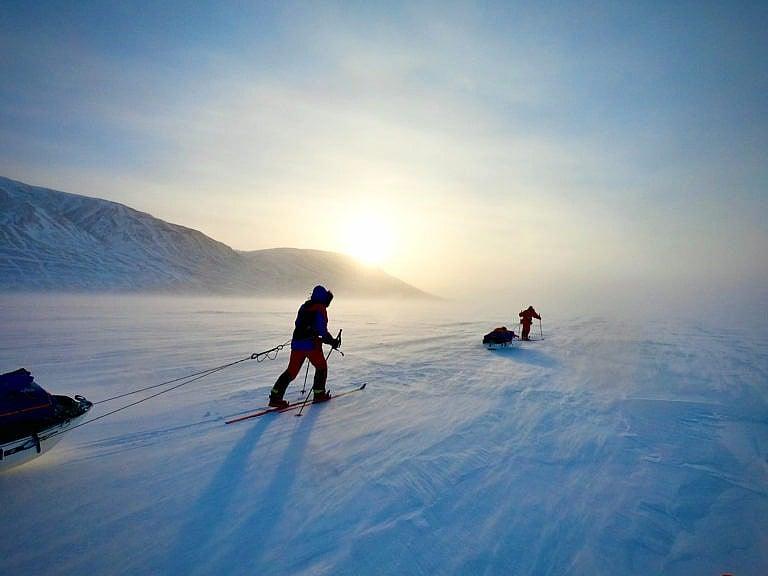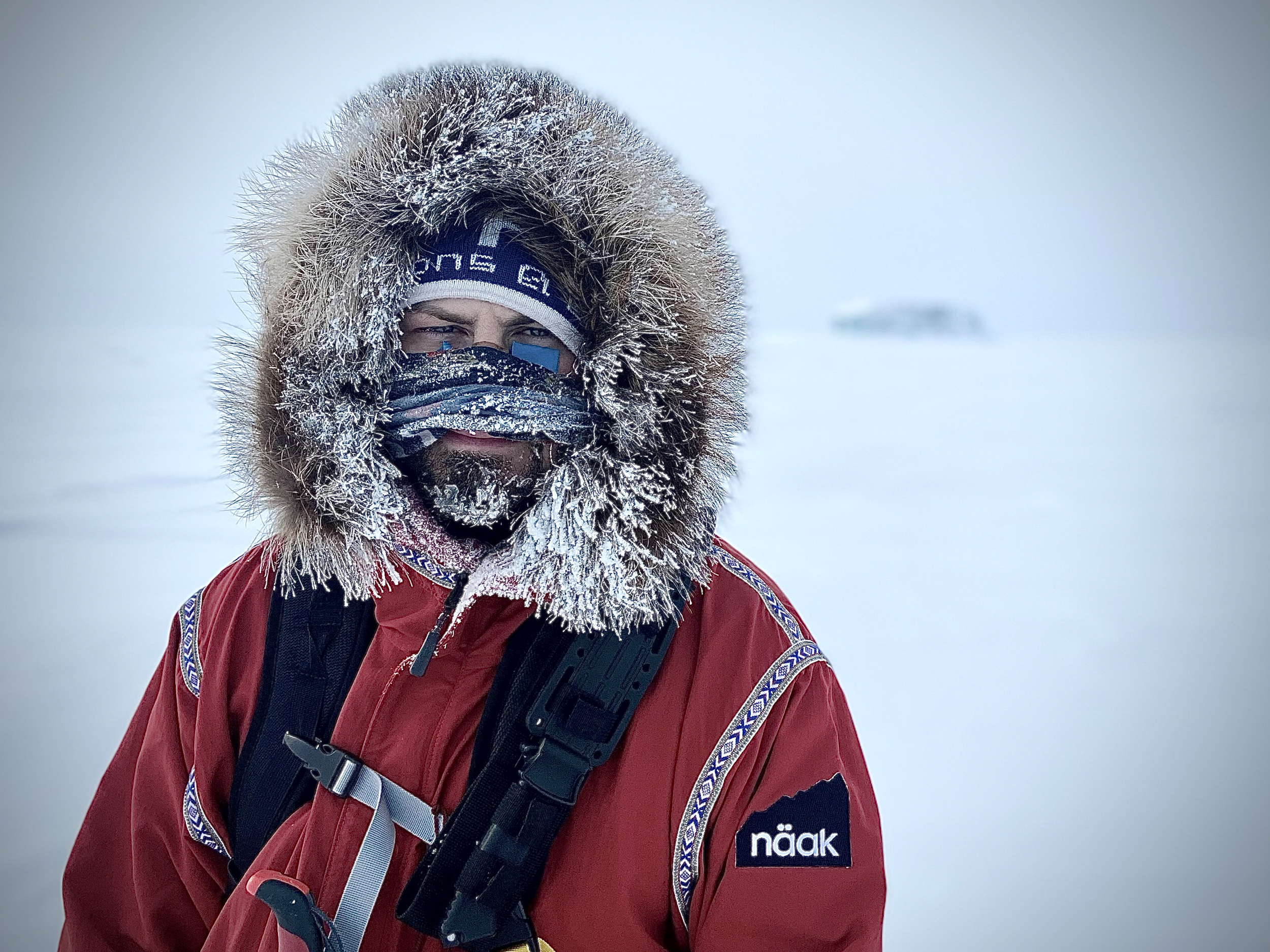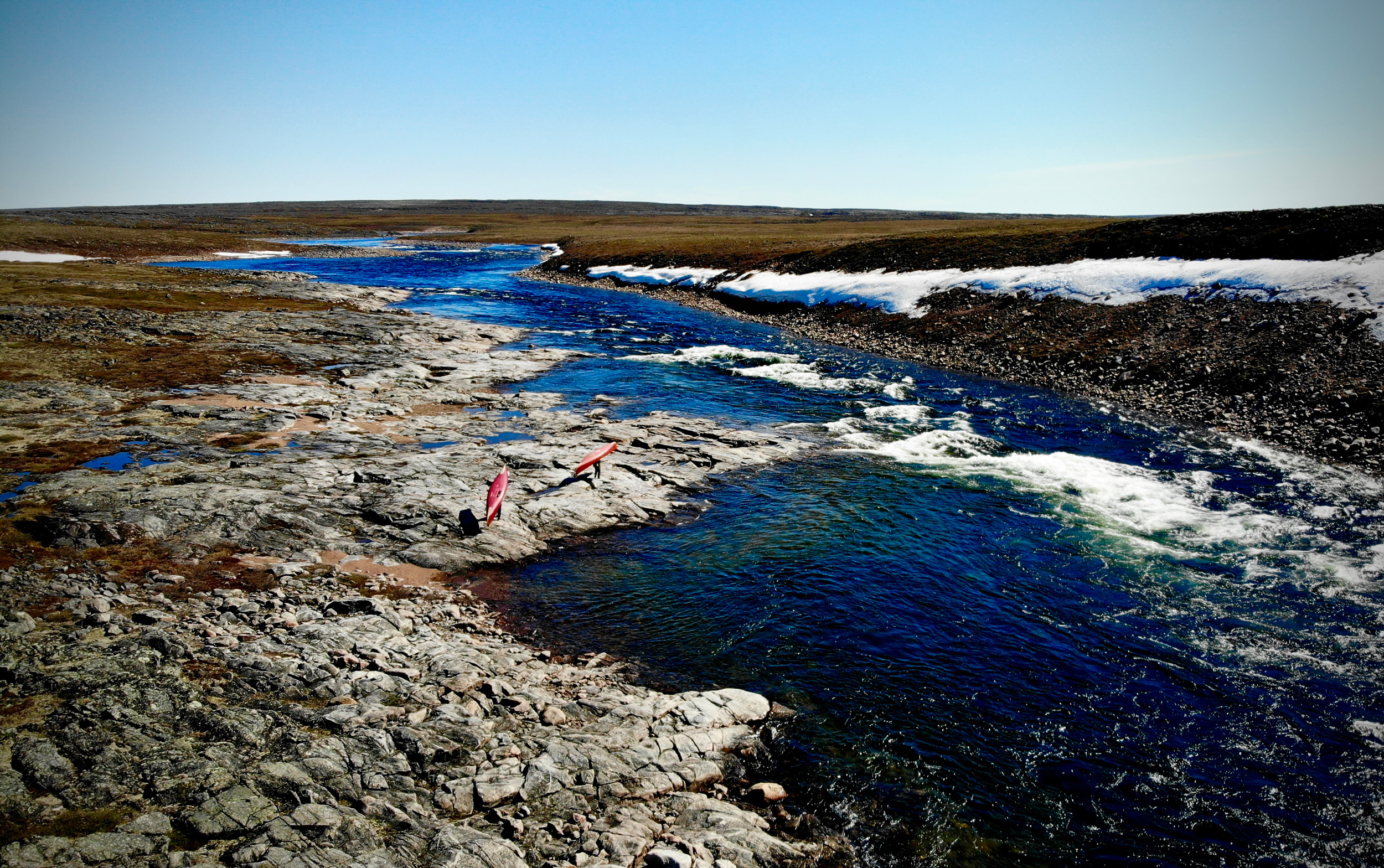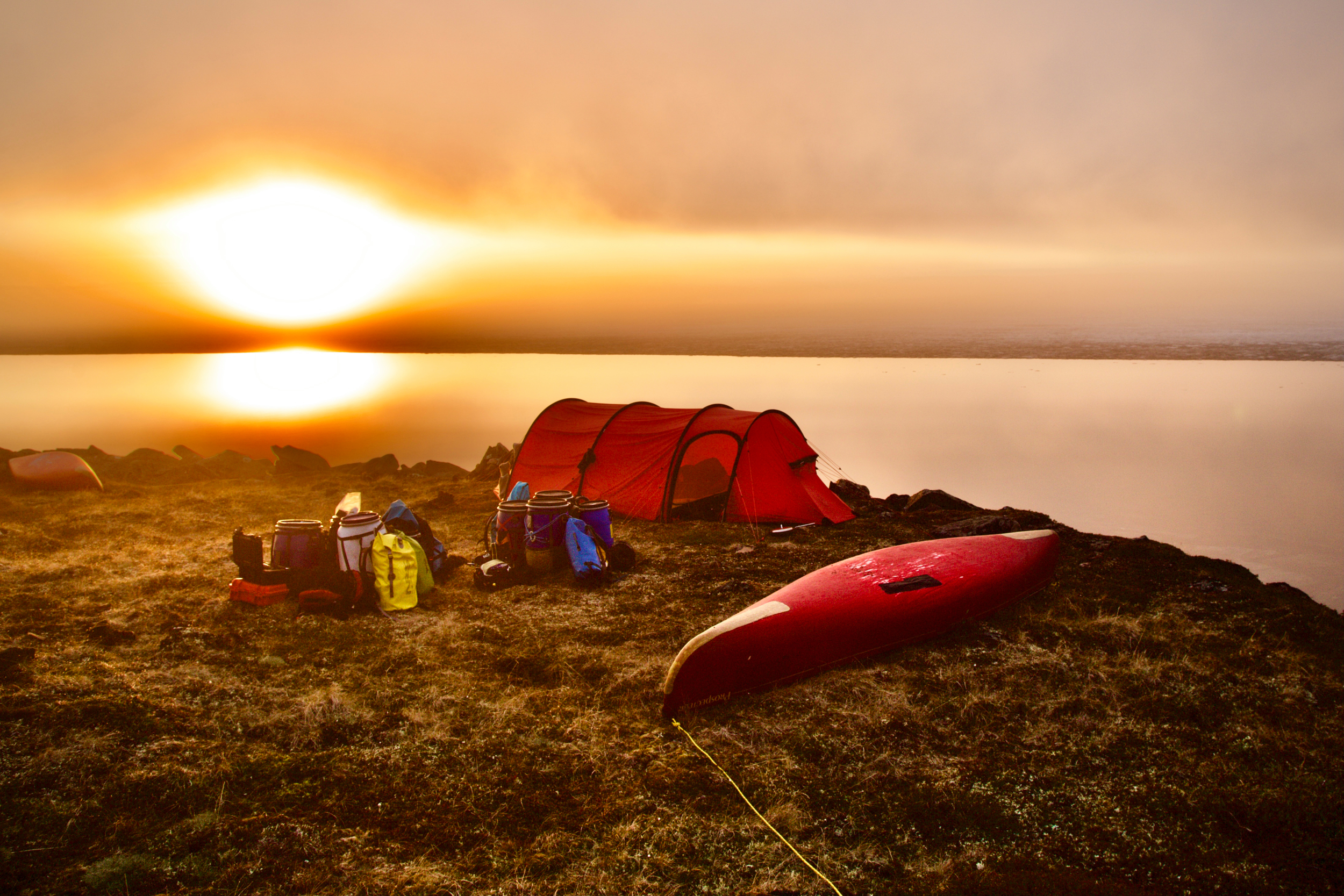These adventurers are on a 7,600-km journey from the top to the bottom of Canada
A team from Quebec has set out on a gruelling and unprecedented seven-month expedition by ski, canoe and bike

Roulx and Moreau, pulling sleds with more than 100kg of gear, on the first leg of the 7,600-km journey. (Courtesy of the AKOR expedition)
Share
Guillaume Moreau could barely lift his feet. His knees were in too much pain as he skied across Canada’s northernmost island, Ellesmere, amid -30° C weather while pulling a sled with 135 kg (300 lb) of gear and supplies.
He looked up at his friend Nicolas Roulx, who shared his dream of completing the longest uninterrupted north-south crossing of Canada. He looked at Jacob Racine, a professional adventure guide who would accompany them for the first portion of their journey, a two-month stretch they’d do on skis. There wasn’t much else to look at on days when the snow-covered land met the clouds at the horizon, forming a white backdrop as far as the eye could see. It was as though they were moving inside a giant ping-pong ball.
The trio had been travelling upwards of 12 hours a day, trying to hit a daily goal of 20 km but often falling short because of Moreau’s injured knees. When they traversed particularly rough ice, Roulx and Racine would take off their skis because walking offered better traction. But with his knees screaming at him, Moreau could only forge on by skiing, so the team slowed down even more. After several weeks, they came to rest for a night near small, uninhabited Graham Island in northern Nunavut. Moreau could barely sleep. The pain in his legs was worsening each day, and his mind wouldn’t stop racing.
READ: Layton Keddy disappeared into the Australian wilderness
This was only the beginning of a 7,600-km journey that, if completed, would set a new standard for land crossings of Canada. Still in progress as of this writing in late August, it is a gruelling quest in three epic stages: a two-month ski across the ice floes of the High Arctic; a canoe odyssey on the rivers and lakes of Nunavut’s mainland toward northern Saskatchewan; and finally, a bike ride all the way to the Canada-U.S. border in southwestern Ontario.
But now, having slogged for weeks across snow and ice, they were barely a few hundred kilometres from their starting point in Eureka and Moreau was struggling to make it to their first resupply station in Resolute Bay. “It was a very dark time for me,” he says. “The dream was suddenly close to a nightmare.”
So he started what he called “a strong cocktail of medication” for the inflammation in his knees, and he altered the way he pushed off as he skied to reduce the pressure on his legs. Roulx and Racine each took some of the weight from Moreau’s sled, and the trio pressed on until, after 40 days of skiing, having started off with exactly 40 days worth of food, they reached Resolute Bay to rest and restock.
Moreau and Roulx weren’t naive enough to think they’d get through a seven-month expedition without injury. But there would be other setbacks that they had not anticipated when they started planning this adventure in 2018: bodies of water normally frozen but now impassable by skis because of an early thaw; canoes damaged by the harsh climate before the group even started paddling; and one team member who would join the canoe leg, only to announce he was heading home at the midway point, leaving the others scrambling for a last-minute replacement.
But as Moreau rested his legs in Resolute for a couple weeks, the team focused on another full month of skiing across Nunavut to their second resupply station, 700 km away in Gjoa Haven. “When you’re carrying over 300 pounds every freaking day for more than two months, and it’s the only thing you do,” says Roulx, “sometimes you ask yourself: ‘Why the f–k am I here? And why did we have this idea?’”

***
Countless Canadians have crossed their country from east to west, and west to east, walking, running, pedalling, rollerblading, canoeing. But no one is known to have traversed Canada from north to south, from Cape Aldrich on Ellesmere Island to the southern tip of Point Pelée on Lake Erie.
Canada measures about 880 fewer kilometres from north to south than it does from east to west, notes Jerry Kobalenko, an Arctic explorer and editor of ExplorersWeb. “But the lion’s share of it is serious wilderness. You’re dealing with polar bears in the North, water crossings and the cold.”
Kobalenko couldn’t see himself tackling the challenge, but mentioned the idea to his friend, Noah Nochasak, an expert sea kayaker from Nain, Labrador. Nochasak was sufficiently inspired to plan the entire route, right down to listing resupply stations, as part of his studies for an adventure guide diploma program at Thompson Rivers University in Kamloops, B.C. But a trio of concussions that he’d suffered while kayaking in the years after writing the paper ultimately left him unable to take up the expedition himself.
Then, in the summer of 2018, a group of Quebecers arrived in Nain, the end point of a two-month, 1,600-km canoe trip they’d taken across northern Quebec and Labrador. Among the group were Moreau, a post-doctoral forestry science student at Université Laval, and Roulx, a high school history and geography teacher in Quebec City. Nochasak went out to meet them and, as they got to chatting, he told Moreau and Roulx about an even bigger adventure they could try. He even offered them a copy of his university project. “I give the paper to a lot of people, and most of them just laugh it off,” he says. “It was a pleasant surprise that these guys accepted the paper and made a route of their own.”
The day Moreau got home, he began looking at Google Earth for a suitable path—one doable by canoe, their preferred discipline, and not sea kayak, as Nochasak envisioned for himself.
It took years of planning, sending gear and supplies ahead to communities in the North, and physical training for the ultra-long journey. The COVID-19 pandemic demanded its own form of navigation, which included required paperwork and quarantines before their group, dubbed Expédition Akor, arrived in Nunavut in March 2021. They opted not to begin at Canada’s northernmost point of land: the extra $25,000 to charter a plane for a few hundred more kilometres of skiing was more than they could afford. Instead, they set out from Eureka, about halfway down the western shore of Ellesmere Island, on a journey they aimed to complete in early autumn. By the time Moreau, Roulx and Racine reached Resolute Bay, however, the bordering Barrow Strait they’d planned to cross by skis was no longer frozen.
Satellite images showed a possible ice bridge 200 km to the west, a detour that would take several weeks. But it would require nearly double the food supply, and their sleds were already heavy. They also had two friends, Philippe Voghel-Robert and Étienne Desbois, who’d be waiting for them in Gjoa Haven—where their canoes had been in storage for months—to join the second stage of the adventure; from there, Racine planned to fly home to Quebec. Delaying their arrival by weeks would lead to logistical problems throughout the rest of their trip. What’s more, the ice bridge could very well be impassable when they saw it up close.

Moreau on Ellesmere in April; 'The dream was suddenly close to a nightmare' (Courtesy of the AKOR expedition)

By late June, they were back on track. (Courtesy of the AKOR expedition)
The team’s conversation about what to do next was relatively short: the most important thing was their safety. They chartered a plane to fly 120 km across the water. “We challenged ourselves to do the crossing of Canada only by human power,” Roulx says. “Now, it’s 98 per cent. But we didn’t have any alternative.”
Not long after they landed and were back on skis, they came across polar bear tracks. On a few occasions, Racine pointed out what he figured was an ice mound in the distance they could use as a reference point for skiing in a straight line. But, when they got closer, they would find that the mound was in fact a napping bear. One encounter had them standing metres away from Ursus maritimus, Roulx says, though they did not feel endangered. The team had specially designed pyrotechnic cartridges known as “bear bangers,” which they used successfully to scare off some 15 polar bears over the course of their two months on skis.
When they stopped to rest at night, they would set a perimeter alarm around their campsite—a chain of temperature sensors to alert them if a large mass of heat in the form of a polar bear passed by. Roulx recalls taking turns keeping watch one night when several bears came near their tent. “That was hard,” he says. “When you know there are bears, you don’t sleep.” A 12-gauge shotgun stood by as a last resort, but they never had to use it.
As temperatures warmed to approximately -5° C and they travelled farther from Resolute, the group managed to ski more than 25 km a day, reaching Gjoa Haven in 24 days. There, they bid adieu to both Jacob Racine and their skis, and welcomed Desbois and Voghel-Robert to continue the journey by canoe.
***
Cracks started to appear on the hull of one canoe two weeks after the team left Gjoa Haven as they pulled it, filled with their supplies, across the ice for the next leg of their trip. “We didn’t spot the damage before we started to paddle,” Roulx says. “There was some water infiltration and it cracked the canoe from the inside. It was a serious hole in the boat.” The group figured the damage was a result of their materials’ exposure to the elements during months of storage in the North. Not long afterwards, their second canoe started to show similar problems.
There was no practical way to get new canoes delivered, but they had a repair kit, which allowed them to patch their boats and paddle on, albeit with extra care to avoid rubbing up against rocks.
Their planned route along Back River proved too dangerous because of the risk of flooding and ice breakup, so the team stroked and portaged down a chain of adjacent rivers and lakes toward Baker Lake, Nunavut. They saw caribou and swans, as summer temperatures brought the mosquitoes out in force. On a mini-detour to the top of Meadowbank Mountain—about 57 m above sea level—they found rock circles, Inuit artifacts and what appeared to be a tool made from the bone of a caribou leg.
They left everything in its place, Roulx says, explaining: “We’re not archaeologists. But we always take photos and waypoints with GPS, and we’re going to send them to the Government of Nunavut so they can check it out.”

At a stop in between Gjoa Haven and Baker Lake at the beginning of July; the canoe bears a patch that helped keep the adventure afloat. (Courtesy of the AKOR expedition)
During the long days of pushing one another to keep going, some members of the group began struggling with what Roulx describes as “interpersonal issues.” He declines to elaborate, but when the group reached Baker Lake in late July, Voghel-Robert announced he was heading home. Now without two people per canoe to battle currents and manage portages, the remaining team members wondered if they could find anyone willing and able to drop everything to fly to Nunavut for six weeks of paddling.
Moreau immediately thought of one outdoor enthusiast with experience in the tundra, who was also a strong canoeist trained in both whitewater rescue and wilderness medicine: his girlfriend, Catherine Chagnon. She recalls arriving home in Quebec City from a camping trip where she had no internet or phone signal. “I called Guillaume because I knew he’d arrived in Baker Lake,” she says, “and he asked me: ‘Would you like to come here?’ ”
Moreau warned that the next leg would be physically demanding: at least 45 consecutive days in canoes for about 1,100 km of paddling upriver. “I’m strong, but [only] strong for my weight,” Chagnon says. “I’m like 100 pounds.” The men told her they’d be in no rush on the water, and within days she arrived at Baker Lake, the self-described “geographic centre of Canada.” There, two red canoes were going through another round of repairs before the party set off in late July.
The four adventurers arrived in late September at Wollaston Lake, Sask., where their bicycles awaited. They were a few weeks behind schedule—75-km/h headwinds had prevented them from paddling a single kilometre during five of their first 14 days on the water. But their spirits remained high. The two most physically taxing portions of the longest north-south expedition in Canadian history were behind them, and two more friends had joined for the final stretch. Only 4,000 km by bike to go.